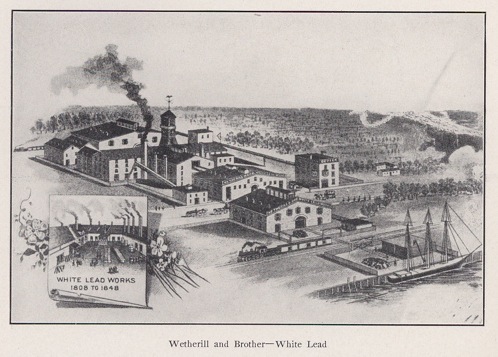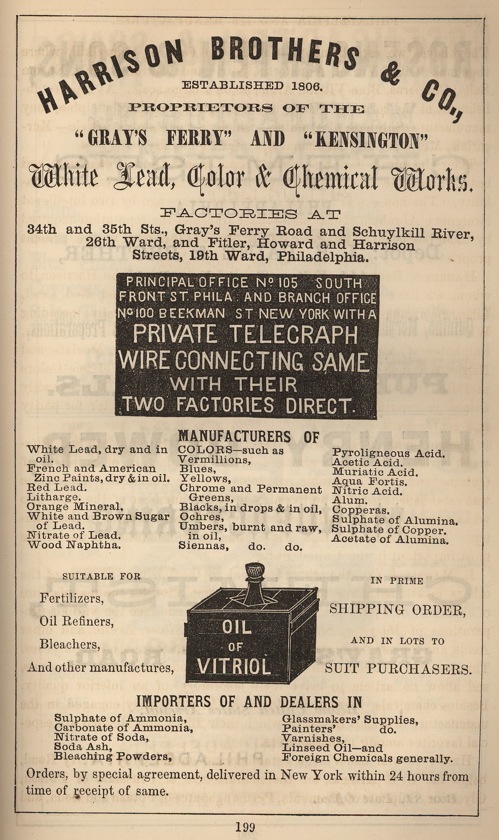
"The chemical industry of the United States was not developed until after the revolutionary War... The paint and varnish industry may be said to have started with Samuel Wetherill. He was an agent for English manufacturers of white lead. He succeeded in making white lead as early as 1787. Later he decided to build a plant for its manufacture, when he was warned that if he did so the English manufactures would not all the enterprise to succeed. he was advised to build so that in case of failure it could be readily changed into a brewery. In 1804, a short time after the plant was erected, it was destroyed by fire. The day after the fire a young Englishman in his employ disappeared. It was always believed that he had been bribed by English rivals to set fire to the plant. Nothing daunted he rebuilt in 1808. The interruption of commerce with Europe by the Embargo and Non-Intercourse Acts and the war of 1812 gave Wetherill time to establish the manufacture of white lead on a firm footing."—Manufacturing in Philadelphia, 1683-1912, pp. 58-60.
E.I. DuPont de Nemours Company, Marshall Laboratory
3500 Grays Ferry Avenue, Philadelphia PA 19146
© John Mayer,
Workshop of the
World (Oliver Evans Press, 1990).
This twentieth century
complex was built up on the site of the Harrison
Brothers, Grays Ferry Chemical Company. Harrison Brothers
was one of the largest chemical companies in the South
Philadelphia area, employing nearly 500 workers in its
paint production operations by the 1890s.
1
John Harrison began producing sulfuric acid in
Philadelphia in 1804. In the years that followed
his company moved several times, occupying sites in such
neighborhoods as Spring Garden, Frankford, and
Kensington. With the assistance of a German chemist, Eric
Bollman, Harrison added a platinum still to his refinery.
This change dramatically improved the distillation
process and enabled the continuous production of
acid. 2

© Edwin T.
Freedley, Philadelphia
and its Manufactures (1867), p.
199.
Harrison Bothers bought the property on Gray's Ferry
Avenue in 1863 and began a period of expansion that
continued through the 1900s. 3
By 1910, the
massive complex included facilities for paint mixing,
solvent production, sulfuric acid production, and various
processes based on the by-products of these operations.
In its efforts to assume a dominant role in the chemical
industry, the DuPont Company purchased Harrison Brothers
in 1917. Paint manufacturing continued at the site until
the 1950s, when DuPont began to concentrate on research
and development projects. Today, the Marshall Laboratory
is involved in fundamental research on paint
manufacturing, the chemical and physical properties of
paint, and product development. Unfortunately all
nineteenth century structures have been demolished, the
last in 1983, and have been replaced with contemporary
structures and parking facilities.
1 Lorin Blodget,
Census
of Manufactures of Philadelphia, (Philadelphia, 1883), p. 103.
2 see Werner S.
Zimmt, "Notes
on the Development of [the] Chemical Industry in the
Nineteenth Century through University-Industrial
Interaction as Illustrated by Two Products made by John
Harrison of Philadelphia," unpublished research paper,
University of Pennsylvania, 1981.
3 Hexamer General Survey #162 "Chemical
Works, Harrison Bros. & Co."
Hexamer General Survey #631 (1872) "Gray's
Ferry Chemical Works, Harrison Bros. &
Co."
Hexamer General Survey #1206-1207
(1878)
Hexamer General Survey #1483-1484 (1880)
"Gray's Ferry Chemical Works, Harrison Bros. &
Co."
Hexamer General Survey #1767-1768 (1883)
"Gray's Ferry Chemical Works, Harrison Bros. &
Co."
Hexamer General Survey #1961-1962 (1885)
"Grey's Ferry Chemical Works, Harrison Bros. &
Co."
Hexamer General Survey #2195-2196 (1888)
"Grey's Ferry Chemical Works, Harrison Bros. &
Co."
Hexamer General Survey #2445-2446 (1891)
"Grey's Ferry Chemical Works, Harrison Bros. &
Co."
Hexamer General Survey #2777-2778 (1894)
"Grey's Ferry Chemical Works, Harrison Bros. &
Co."
Hexamer General Survey #2779-2780 (1894)
"Grey's Ferry Chemical Works, Harrison Bros. &
Co."
Update
May 2007 (by Joel
Spivak):
No change.